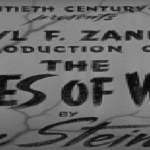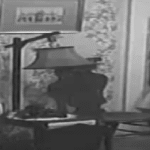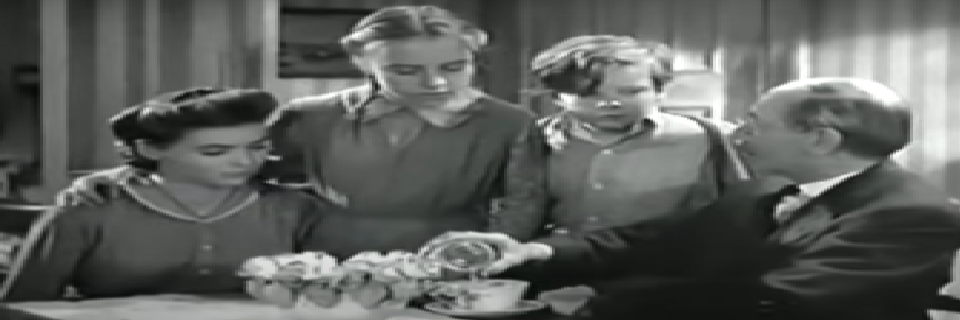In the rich tapestry of classic American cinema, A Tree Grows in Brooklyn (1945) stands as one of the most tender and truthful portrayals of family, poverty, and perseverance. Based on the beloved 1943 semi-autobiographical novel by Betty Smith, the film marked the directorial debut of Elia Kazan, who would go on to become one of the most influential figures in 20th-century American film and theater. With its emotionally rich performances and subtle realism, A Tree Grows in Brooklyn is a timeless story of growth, both personal and generational.
Set in early 20th-century Brooklyn, the film follows the life of the Nolan family, primarily through the eyes of young Francie Nolan, a bright, imaginative girl growing up in the Williamsburg slums. The tree referenced in the title is a metaphorical and literal symbol: a tenacious tree that grows outside Francie’s window, flourishing despite its harsh, urban surroundings, just as the Nolan family strives to survive and blossom amid the constraints of poverty.
Francie, played with poignant sincerity by Peggy Ann Garner, is the emotional heart of the film. Through her, we witness the day-to-day struggles of her family: her hardworking, pragmatic mother Katie (Dorothy McGuire), her dreamer and alcoholic father Johnny (James Dunn), and her mischievous younger brother Neeley (Ted Donaldson). Their lives are filled with hardship, yet imbued with small triumphs and a deep familial bond.
Though A Tree Grows in Brooklyn was Kazan’s first film, his background in theater (particularly with the influential Group Theatre) is evident in his sensitive, performance-driven direction. Kazan avoids melodrama, choosing instead to lean into realism and nuance. He captures the intimate rhythms of working-class family life with compassion and restraint. His camera lingers in quiet moments, Francie reading a book, Katie silently scraping together food, Johnny telling tall tales to mask his shortcomings, creating a world that feels lived-in and achingly authentic.
Kazan’s approach allowed his actors to shine, especially James Dunn, whose portrayal of Johnny Nolan earned him an Academy Award for Best Supporting Actor. Dunn, himself once a fading star, brought a heartbreaking honesty to the role of a father whose charm and optimism are undermined by his addiction and inability to provide. His performance is equal parts lovable and tragic, a man desperately clinging to his dreams even as reality crumbles around him.
The emotional weight of the story lies in the dynamic between Katie and Johnny, two fundamentally different people united by love and circumstance. Katie, portrayed with quiet strength by Dorothy McGuire, is the bedrock of the family. She sacrifices, strategizes, and sometimes hardens herself to keep her children fed and housed. Her realism borders on coldness, especially in contrast to Johnny’s romanticism, but her resilience is the reason the family endures.
Their opposing philosophies about life, Katie’s practicality versus Johnny’s idealism are mirrored in the struggles of Francie, who is caught between worlds. She inherits her mother’s determination and her father’s imagination, which makes her both hopeful and aware of the limitations around her. Through Francie, the film explores themes of class, education, and personal growth. Her desire to attend a better school, read great books, and rise above her circumstances speaks to the universal yearning for a better life.
As Francie, Peggy Ann Garner delivers a performance of extraordinary depth and maturity. Only 12 years old at the time of filming, Garner conveys a complex blend of innocence, intelligence, and emotional sensitivity. Her portrayal won her a special Juvenile Academy Award and remains one of the finest child performances in classic Hollywood.
Francie’s journey is one of emotional maturation. She faces loss, disappointment, and the painful realization that the adults in her life are flawed. Yet she also experiences beauty through literature, family affection, and the simple pleasures of childhood. Francie’s arc is not about dramatic transformation but about learning to see the world clearly and still finding reasons to believe in it.
The tree that grows outside the Nolan family’s tenement becomes a powerful motif throughout the film. It symbolizes endurance, hope, and the ability to thrive under adversity. In one of the film’s most memorable scenes, Francie watches the tree from her window, its branches stretching skyward despite the harsh environment. This imagery is not just poetic but emblematic of the immigrant and working-class experience in early 20th-century America growing, striving, and pushing upward in defiance of the odds.
This symbolism also underscores the film’s central message: that beauty and strength can emerge from struggle. Much like the tree, the Nolan family is not protected from life’s storms, but their roots of love, sacrifice, and perseverance anchor them through it.
While the film’s emotional core rests on its characters and performances, its technical elements enhance its impact. Leon Shamroy’s black and white cinematography captures the textures of tenement life with soft shadows and glowing highlights. The production design carefully recreates the look and feel of Brooklyn’s working-class neighbourhoods, with cobbled streets, laundry lines, and bustling corner stores.
Alfred Newman’s musical score is understated yet evocative, lending a gentle warmth to the film’s most tender moments. The music never overwhelms, instead serving as an emotional undercurrent that complements the narrative’s quiet strength.
A Tree Grows in Brooklyn was both a critical and commercial success upon its release, earning multiple Academy Award nominations and solidifying Kazan’s place as a director to watch. Its emotional honesty and social relevance helped pave the way for more grounded family dramas in post-war American cinema.
The film’s depiction of poverty was especially notable. Unlike many films of the era, it did not romanticize the working poor but instead offered a nuanced portrayal acknowledging the hardships without denying the dignity of those enduring them. This honest approach resonated with audiences then and continues to speak to viewers today.
Over the decades, A Tree Grows in Brooklyn has maintained its reputation as a sensitive and enduring piece of filmmaking. It has inspired countless adaptations and remains a staple in discussions of classic coming of age stories.
A Tree Grows in Brooklyn is not a film of grand gestures or sweeping melodrama. It is a film of small moments, quiet strength, whispered dreams, hard choices, and the enduring power of hope. Its beauty lies in its honesty, its recognition that life is often hard, but also often filled with grace.
Through Elia Kazan’s direction, outstanding performances, and a narrative rooted in personal truth, the film plants a lasting seed in the viewer’s heart, reminding us that even in the harshest soil, something beautiful can grow.







